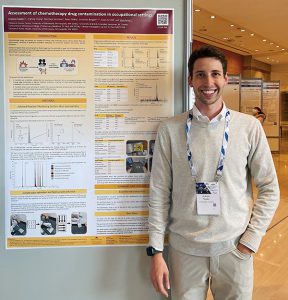 Andrew Floeder, a PhD Candidate in the Occupational and Environmental Epidemiology (OEE) program, recently disiplayed his research poster at two prestigious international events.
Andrew Floeder, a PhD Candidate in the Occupational and Environmental Epidemiology (OEE) program, recently disiplayed his research poster at two prestigious international events.
Andrew traveled to Athens, Greece in September to attend the International Society for Environmental Epidemiology (ISEE) Conference. His poster was also presented at the International Society of Exposure Science (ISES) Annual Meeting in Lisbon, Portugal by Dr. Susan Arnold.
His poster was titled “Assessment of chemotherapy drug contamination in occupational settings”.
Overall, I had a great experience at ISEE! I was able to present my research at a large-scale conference and a new research setting. At the conference, I was able to meet experts in their field, learn about interesting research topics, participate in poster discussions, and learn up-to-date research strategies and techniques.Andrew Floeder
ABOUT ANDREW’S RESEARCH
The American Cancer Society estimated there would be more than 1.8 million new cancer cases diagnosed in 2020, an increase of 55% over the last 15 years. This correlates with an expected 58 million patient oncology clinic visits in the United States. The increase in cancer incidence and patients undergoing chemotherapy has exacerbated the need for oncology technicians to administer treatment and patient caregivers to act as a support system. Cancer is also the leading cause of death in dogs, with an estimated 1 in 3 dogs developing the disease. Similar to cancer incidence and chemotherapy treatment for humans, cancer chemotherapy for dogs has become more common. Dogs treated with antineoplastic drugs may act as a source of secondary exposure, but the extent of surface contamination from antineoplastic drugs is currently unclear. This research aims to quantify potential exposure to healthcare workers and dog owners, and to understand better and characterize the health risks associated with workplace exposure to chemotherapy drugs. Achieving these goals will help inform effective strategies to eliminate hazardous exposures in the clinic and potential secondary home exposure.
SHARE

